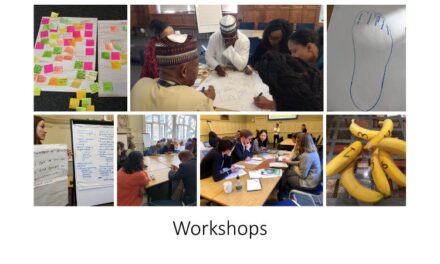This blog was written by Nina Pavlovska, Training and Innovation Manager, and Marina Todesco, Research Specialist, at Dance4Life. Marina will be making a presentation at the September 2019 UKFIET conference on inclusive education systems.
Curricula for young people are generally developed by experts, following national guidelines, and are therefore often based on the agendas of the adults involved. The result is that they are less relevant for the end-users, who are excluded from the development process. The involvement of learners in the design phase of a curriculum can increase their motivation and participation, improving the quality of learning. This kind of facilitated learning experience design is particularly important if we want to ensure that education is learner-centered.
In 2016, the Dutch organization Dance4Life co-created (with young people from Ghana, Kenya, Nepal, Zambia, Indonesia and Russia) the Journey4Life, a sexuality education curriculum building socio-emotional competencies with the aim of enhancing (sexual) well-being. The organisation believes that the inclusion of the end-users in curriculum design is an effective way to make education more relevant and to ensure that it reflects the learning ambitions of the users. The Journey4Life is designed for youth aged 10 to 24, to help them critically think about themselves, their relationships, social norms influencing their behaviours, and to take action towards improving their lives and the communities they live in.
The co-creation process took about one year and was based on the human-centered design approach. Eight main steps are at its core and can be adapted and used by educational institutions and organisations aiming to develop curricula which is more relevant to their end-users. Here is a summary:
- Start with the people: the inclusion of end-users is the core essence of co-creation. They know better their own needs and aspirations, the challenges they face and how they love to learn. Value them as human beings, embrace uncertainty and let go: give up your assumptions and trust them. There is so much you can learn from their experience and from this process!
- Inspire with the “Why”: inspiring the co-creators with the impact the curriculum might have is a fundamental step to engage and motivate them in taking part in the co-creation process. Co-creation of a curriculum is indeed a unique opportunity to collaborate together to make substantial change in the development of a product that strongly resonates with its end-users.
- Set the destination and travel guidelines: it is key that all co-creators agree on the goal of the curriculum and believe in its potential to achieve it. This creates a strong sense of ownership of the process and the product. A framework is needed to guide the co-creators in designing content and activities in line with the agreed goal. A clear structure must be in place to avoid going off topic, and it needs to be flexible enough to allow creativity and innovative thinking.
- Boost creative confidence: train the co-creators in creative thinking and the human-centered design approach, so that they can develop the attitude and skills to think outside the box and playfully engage in designing content and activities which are experiential, fun and relevant to the end-users.
- Enable self-growth through prototyping: encourage co-creators to prototype content and activities designed amongst a small number of people. This will allow them to better understand the process, gain new insights that might challenge their initial idea and to learn. Activities will be even more relevant and user-centered.
- Involve experts: external expertise is required to look at the curriculum from a different perspective. Make use of external experts when it’s time to put all the pieces together. They are a useful resource to give additional help and feedback.
- Test the MVP and refine it: find the courage to test your minimum viable product (MVP) even if you have the feeling it is not ready yet. Difficulties encountered – or maybe a failure – are the only way to improve the curriculum. Incorporate the lessons learnt and make the necessary updates.
- Co-creation never ends: the world and human beings are in constant change and your product needs to be adaptable to new situations. Build a dynamic curriculum that can be adapted depending on the context and make sure to always include the end-users in its contextualisation.
Through following the eight steps above, Dance4Life co-created the Journey4Life curriculum which is made up of 12 core sessions. It is currently being delivered in 9 countries around the world, by peer educators who are trained in participatory facilitation methodology. The content and the mode of delivery are also inspired by Sir Ken Robinson’s ideas about creativity in education, Dewey’s and Lipman’s conceptualisation of the community of inquiry, together with the most up-to-date evidence in the field of comprehensive sexuality education (See the 2018 UNESCO International technical guidance on sexuality education).
Between 2017 and 2018, the Journey4Life was piloted in Ghana, Nepal, Russia and Tanzania. Findings from the evaluation of the pilots were positive and encouraging: changes in behaviours, increased gender equal attitudes and higher reflection on social norms were visible, together with enthusiasm expressed by teachers and peer educators about the mode of delivery of the curriculum.





